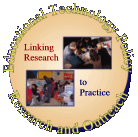|
|
- The National Cryptologic Museum led by curator Jennifer Wilcox. The tour began with speakers discussing NSA employment and opportunities as well as additional options such as summer programs and internships. This tour was one of the favorites of all students.
|
- The APL tour was led by Outreach and Community Coordinator Connie Finney
- First stop: video overview of what APL is involved in and career connections through a guest speaker.
- The speaker emphasized networking, internships (even if voluntary), team work, collaboration, problem solving and independent thinking, communication skills (written and oral), as well as grades. "But experience is a must in today's economy-so get an internship."
- Messenger primary investigator discussed and then showed the Messenger Spacecraft being built and tested (Mission to Mercury)
|
- The NIST tour was led by Barbara Cuddington Clearinghouse Coordinator (Educational Outreach)
- First Stop: Administration Building (101) lobby after clearance for NIST history and overview
- Advanced Chemical Sciences Lab (227), Room B163 Catching
Crooks with Chemistry - William
A. MacCrehan, Research Chemist
- Analytical Chemistry Division - Chemical Science and Technology Laboratory ---to learn more about forensic science related to gun power residues -how they check on peoples hands, hair, composites of different bullet "brands" and much more
- Travel to the Technology Building (225), Room A266
Imaging Quality Lab
- Travel to Engineering. Mechanics Building (202), Room 227
|
Catching Crooks with Chemistry |
 |
 |
 |
|
Manufacturing Weights and Standards |
 |
 |
 |
 |
 |
 |
 |
 |
 |
 |
|
|
|
World Trade Center Beams |
 |
 |
 |
 |

Graphic Map of WTC Crash |
|
|
Robotics |
 |
 |
|
|
The Ride Home |
 |
 |
 |
 |
 |
 |
 |
 |
|
|
|
|
|
|
The Composite Lab Tour in the Manufacturing Building was led by Matt Fox who spoke to us about the mission and activities of the composite lab, before showing us several highlights such as the microprocessor-controlled Baron Autoclave, an MTS 810 series uniaxial testing machine, the largest universal load frame on the College Park Campus, the Composite Extendible Boom (pages 4-6), and the Skirt Design for the Mars Micromission (pages 7-9).
|
We visited the TAP Technology Incubator building to visit two of our program sponsors - AnthroTronix to see technology and educational solutions for physical therapy and DataStream Conversion Services (read more about this top incubator company). |
|
The Anthrotrix visit allowed students to see the direct connection between education and technology. An earlier robot helped children with their physical therapy - students did movements that the robot then mimicked. Today's therapy version goes "faster" by having children (adults can play too) do their PT while playing a technology game. You have to do the full range of movements to get the on screen "martian" to jump and turn while aquiring points.
|
 |
 |
 |
|
|
The trip to the Wind Tunnel was led by Les Yeh. Les explained the history of the Glenn Martin Wind Tunnel and then "walked" us through the various parts of the tunnel. |
 |
 |
 |
 |
|
|
|
|
Megan Weiner and Ronald Luna from the Geography Department spoke to us about the specialization areas in the Geography department-to include Human Dimensions, Earth Systems Science and Geographic Data Science. All emphasize 21st Century Skill knowledge and many combine a technology and education focus. (Dr. Cirrincione is a joint faculty member from Geography and Education). We were able to visit with faculty and staff whose work included: hydrological modeling (viewing seasonal changes in MD's wetlands); carbon cycling in the world's boreal forests; land cover land use changes; and other remote and GIS projects.
|
|
Neutral Buoyancy Lab
At the Space Systems Lab, in the Neutral Buoyancy Facility (scroll down for picture), Dr. Bowden spoke to us about possibilities and activities related to Aerospace engineering and about the neutral buoyancy facilities uses. With the aid of half a dozen great TA's, and supplies which consisted of duct tape (always necessary for space flight), straws, and Styrofoam cups, the group divided up into teams and began construction of a "space vehicle" that could keep the water balloon cargo safe after a 3 story drop into 1 inch of water. The second challenge was to drop the same "space craft" onto solid cement (simulating past Russian space vehicles). See pictures below to see our groups' great constructions. Great activity for future math and science teachers. |
 |
 |
 |

The balloon is a remote control mylar flying vehicle - a must for next years Students, Learning and Technology Program.
|
 |
 |
 |
 |
 |
 |
 |
 |
 |
 |
 |
 |
 |
 |
 |
 |
 |
 |
 |
 |




















